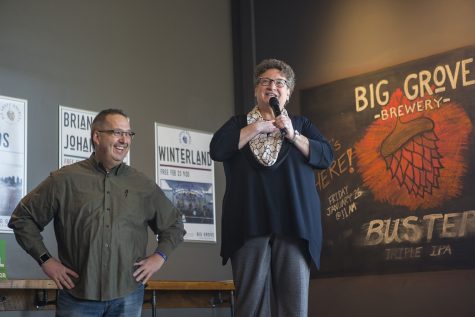UI and Iowa City schools address massive growth in English-language learners
A 250 percent increase of English-language learners in Iowa over the past 20 years is creating a need for more ESL teachers and programs, educators say.
Associate Professor of Education, David Johnson poses for a portrait in the Lindquist Center on Wednesday, Feb. 19, 2020. His research, teaching, and service focus on how language policies impact educational opportunities for students in bilingual education and English language education programs.
February 28, 2020
Experts in the community and local schools are addressing the needs and resources for the growing population of English-language learners in the state of Iowa.
The number of English-language learners in Iowa has increased around 250 percent in the last 20 years, according to records from the Iowa Department of Education. As this population continues to grow, Iowa educators aim to provide ample resources for these students across the state.
“It’s not uncommon for a teacher, say in Cedar Rapids, to have maybe 26 different home languages in a class,” said Lia Plakans, a UI professor who focuses on English as a second language in the College of Education.
UI education Associate Professor David Cassels Johnson said the English-language learning student population is less than the national average, but the population’s growth rate is much higher at the state level compared with the national trend, which has seen 30 percent growth over the last 20 years. He added that most of these students are born in the U.S.
An increase in the English-language learning populations of rural areas has coincided with this growth, Plakans said. Factors of this growth are largely economic, though good living conditions along with safe schools also make Iowa an attractive place to resettle, she said.
Lora Daily, director of learning support for the Iowa City Community School District, said a primary development in the past couple years has been the implementation of English-language learning services in each school building in the district, so kids don’t have to travel to different schools to access the programs.
Sheila Neels, English-language learning coordinator for the Iowa City Community School District, said the top four non-English languages in the district are Spanish, Arabic, French, and Swahili. She added that the district as a whole consists of students who speak almost 90 different languages.
Daily said this rich cultural abundance has made many other districts envy Iowa City schools.
“We’ve learned from that diversity every day,” Daily said.
To help prepare future teachers in adequately educating English-language learning students, the UI offers an ESL-endorsement program to students and current teachers, Johnson said. He coordinates the program.
The UI has a five-year grant with Iowa school districts and the Title III Department at the Iowa Department of Education, called Advocacy, Capacity, and Collaboration for English Learners in Iowa, according to the program’s website.
The grant helps actively promote professional development in school districts all over the state, Johnson said — just being a good teacher doesn’t make someone equipped to teach English-language learning students.
“It’s about teaching methods, it’s about understanding linguistics, and cultural diversity, and how that impacts how students approach schools, and how schools approach students,” he said.
“The way that we educate kids in the United States is culturally specific and its modeled after monolingual middle-class white people,” he said.
These practices aren’t necessarily good or bad, but educators need to recognize that they are culturally dependent, he added.
Daily said Iowa City schools are always in need of more ESL teachers.
“There’s actually somewhat of a shortage of teachers in Iowa, at least that we get applicants for, that have their English as a Second Language endorsement,” she said.
Neels said the Iowa City Community School District’s English-Language Learning services currently offer newcomer programs, sheltered instruction, co-teaching, and small group pull outs.
UI graduate student Alejandro Pérez, a Ph.D. candidate in foreign language and ESL education, worked in a dual-language classroom in West Liberty for three years.
“You need to have ESL teachers who might not speak another language, which is OK, but that are woke, that know how to interact with the students … [and] celebrate [their] differences,” Pérez said.
Rhetoric surrounding nativism makes it especially challenging to do English-language learning work, Johnson said, and makes it more challenging for the kids and their families. He added that most educators are already aware of the educational equality needed for English-language learning students, but the problems tend to lie within policy-making bodies.
“It’s an ongoing struggle to accommodate these students,” he said. “And that’s really sort of the ultimate goal … it’s social justice for these kids.”




















